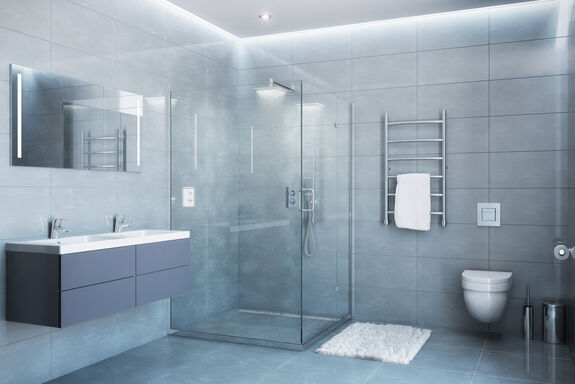Sanitary rooms have evolved over the past decades from purely functional washrooms to small wellness areas with high demands on materials and design. Both in planning and renovation, the bathroom is being incorporated into modern interior design.
The use of different materials such as the combination of wood materials, natural stone, glass, ceramics, metals and various plastics places high demands on the waterproofing systems used and their functionality. Glass in the bathroom is also becoming increasingly popular. Colored and individually printed panes are replacing the classic tiles on the walls.
Shower leaking? Not with EGO!
Durable water resistance and impermeability are basic requirements for sealing showers, shower trays and shower walls
When sealing showers, the joints between wall and floor tiles are not sealed with mortar but with permanently elastic sealants. In the shower area, it is above all the professionally executed connection joints between the wall and the sanitary superstructures such as the bathtub, shower cubicle that are decisive for a perfect sealing function.
Special sanitary sealants or silicones from EGO are also used for sealing and waterproofing showers, corner showers and shower walls.
Due to the increasing demand for accessibility, the installation of floor-level showers is already taken into account during the planning phase. Sealing the drainage channels of walk-in showers places high demands on a carefully designed and sealed shower drain.
The connection between tile and drain or drain channel is the weak point of a shower and requires subsequent sealing. The connections are additionally protected with sealing tapes and moisture barriers and the connection joints of the shower and shower tray are sealed with silic
The joints must have a high resistance to moisture and water. In addition, the joints are also exposed to mechanical and chemical stress from cleaning agents. Due to the high stress and the requirements placed on the silicone sealant, the connection joints must be cleaned, maintained and checked at regular intervals as maintenance joints in order to protect the functionality and thus the building fabric from moisture and water entering and to prevent associated consequential damage and mold infestation.
In 10 steps to the perfect joint in the shower area
- During joint renovation, the old joints are first removed mechanically with a joint cutter or carpet knife (cutter). Sealing systems underneath the ceramic coverings and the connection areas must not be damaged in the process.
- The existing joint sealant should be removed as far as possible without leaving any residue.
- The adhesion-reducing layers on the adjacent areas must be removed with a suitable Cleaner.
- The substrate, joint flanks and bonding surfaces must be clean, dry, grease-free, solid and load-bearing.
- In case of mold infestation of the joint sealant and the joint, the mold must be completely removed with a suitable Cleaner.
- If necessary, pre-treat the bonding surfaces with a Primer and backfill with a non-water-absorbent round cord to prevent three-sided adhesion.
- The specified minimum flash-off time between the application of the Primer and the application of the joint sealant must be observed.
- The new joint sealant is now applied evenly and without bubbles, taking into account the proper joint formation.
- If necessary, the sealant is then smoothed with a suitable smoothing agent. The excess smoothing agent must be removed immediately to avoid contamination of adjacent components.
- The curing times of the sealant must be taken into account before using the sanitary object.
FAQs about sealing showers
Silicone. Large component movements can only be compensated by elastic sealants with a high permissible total deformation (TDS). The sealant must also be fungicidal and have low shrinkage. Acrylics exhibit only moderate elongation and moisture resistance and also have higher volume shrinkage during curing.
In the shower area, connection and movement joints between the wall, bathtub, shower enclosure, the shower drain, shower partitions and, if necessary, the connection between tiles and windows are taken into account.
Also here the waterproofing is done with a silicone sealant. For floor-level showers, it is essential to ensure good drainage and a slight slope of the floor to avoid flooding in the bathroom.
For the sealing of connection and movement joints in natural and artificial stone, special migration-free, natural stone-compatible oxime-curing neutral silicones are used. In contrast to acid-crosslinking acetoxy silicones, these products do not cause edge zone contamination on natural stone due to plasticizer migration!
The joint dimensions must be observed. The joint dimension is determined, among other things, by the load, taking into account the permissible total deformation (ZGV).
The joint width depends, among other things, on the material used, the distance of the sanitary component from the wall, e.g. tile distance from the bathtub or shower, and the individual structural conditions. The sealant in a connection joint must not be stretched and compressed beyond the value of its permissible total deformation (ZGV). For connection joints on e.g. washstands, bidets, WCs or urinals are usually subject to minor movements. Sealing in the form of a triangular joint is sufficient here.
Large-scale waterproofing of the bathroom is carried out with paintable sealants on walls and the floor, sealing tapes and sealing sleeves. Silicone joints can be easily retrofitted and also renewed if necessary. To prevent moisture damage, movement joints must be professionally sealed prior to water exposure and curing times must be observed. Maintenance joints must be cleaned and checked regularly.
For permanent sealing of corner joints, pipe penetrations, connections and water drains, the floor and wall covering such as tiles, natural stone in the wet rooms is laid directly on the waterproofing layer. In addition to the waterproofing coat, the shower tray and tub transitions are protected with a waterproof sealing tape and then with a silicone joint.
As maintenance joints, movement joints must be checked for tightness at regular intervals. If the joints show damage, small cracks or dark spots, the old joints must be removed and professionally sealed with a new suitable joint sealant.









